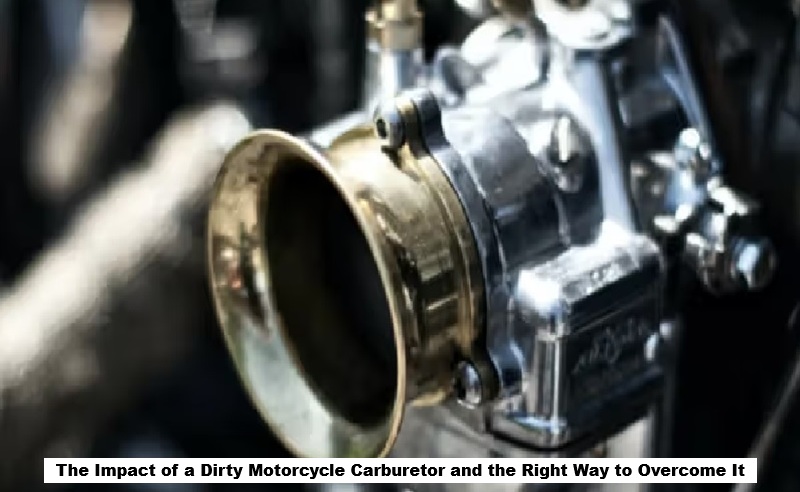Dirty motorcycle carburetors are a common problem for motorcycle users. This is especially true for those who don’t understand the ins and outs of proper engine maintenance.
Motorcycles are one of the most popular vehicles in the world and are used by millions of people every day. However, what happens if one of these vital components experiences an unexpected incident and requires attention, such as a dirty carburetor? What are the consequences? Read on to learn more.

Recognize the Impact of a Dirty Motorcycle Carburetor
With excessive vehicle use and infrequent servicing, motorcycle carburetors often become dirty and even contaminated with deposits. This results in decreased vehicle performance. Here are some explanations about the impact of a dirty carburetor, which requires immediate cleaning or replacement.
Decreased Power Performance
A dirty carburetor will result in a lack of power (reduced performance). Even when driven at maximum speed, the motorcycle will still run slowly.
This is why the carburetor plays a crucial role, as it is the primary mechanism responsible for regulating the intake of air and fuel. This can lead to a delay in air and fuel intake.
According to Prof Berry Channel, a dirty carburetor on a motorcycle can affect its performance. If left untreated, it can lead to unexpected events such as sudden death or accidents.
Fuel Consumption
This further impact leads to increased fuel consumption. A dirty motorcycle carburetor affects low speeds, resulting in excessive fuel consumption.
If fuel consumption increases, the vehicle’s power performance will automatically decrease. If the carburetor is contaminated, the engine will automatically require more fuel to achieve the same performance.
Causes of Engine Noise
A dirty carburetor can cause the motorcycle engine to vibrate or even become unstable during operation. As a result, the engine will produce a noisy sound. When the air and fuel are not properly mixed, the engine components will experience instability that can be felt while riding.
This vibration not only reduces comfort but can also damage other components. If left untreated, this can quickly become a serious carburetor problem.
Engine Difficulty Starting
The vehicle’s engine will be difficult to start, and if started, it will often stall by itself. This is caused by a dirty motorcycle carburetor, which results in suboptimal fuel flow to the engine.
Smoke Coming Out of the Exhaust
The final impact is one of the most fatal problems and results in black smoke coming out of the exhaust and engine. This condition naturally causes vehicle performance to decrease, resulting in the spark plugs running out of oil. Not only does gasoline drain quickly, but engine oil also drains due to carburetor problems.
The Right Way to Fix It
If a motorcycle carburetor is dirty, the vehicle will automatically experience problems such as stalling, stuttering, and difficulty starting. Therefore, vehicle owners must know how to properly clean a motorcycle carburetor.
1. Remove the Carburetor from its Mount
First, you must remove the carburetor from its mount, then position it. However, first, you must have the tools or wrenches ready to remove the carburetor.
2. Open the Carburetor Bowl and Clean
Open the motorcycle carburetor bowl and remove all mounting bolts. Then, check for deposits (contaminated areas). If dirty, immediately clean it with a soft brush and then rinse with clean gasoline.
3. Remove and Clean the Pilot Jet and Main Jet
Next, remove the pilot jet, main jet, and needle jet from the motorcycle carburetor. It’s best to remove them carefully and then clean them by blowing them out. However, it’s easier to use a compressor as a cleaning tool.
4. Clean the Carburetor Nozzle
Clean the carburetor nozzle; this part significantly impacts engine performance. Therefore, it’s crucial to clean it and be careful when cleaning to avoid damaging or changing its diameter.
5. Reassemble the Carburetor
If the above method is successful, you can reassemble and reinstall the carburetor correctly. Next, you can mix the fuel by adjusting the engine float level using a vernier caliper. After that, reassemble all components and reinstall them in their original positions.
Understand the Types of Motorcycle Carburetors Before Replacing Them
For the record, motorcycle carburetors are divided into two categories, based on the shape of the venturi and throttle valve. For example, based on the shape of the venturi, carburetors are classified as fixed venturi, variable venturi, and constant velocity carburetors.
Variable venturi types can be distinguished by their diameter. The diameter of this venturi is adjusted to adjust the size of the fuel-air flow within the carburetor.
Conversely, fixed venturi carburetors usually have a pilot jet for idle speed. When delivering fuel, this carburetor only flows fuel through a needle-controlled jet. The needle itself is designed to be tapered to reduce jet or sprayer impact.
A dirty motorcycle carburetor occurs due to dirt buildup on the valve. If dirt builds up and is not cleaned frequently, it automatically prevents the valve from retracting optimally and causes dragging when pulling the throttle. Therefore, check and maintain it immediately. If you don’t have the proper equipment and time, take it to a reputable repair shop. /Siti
